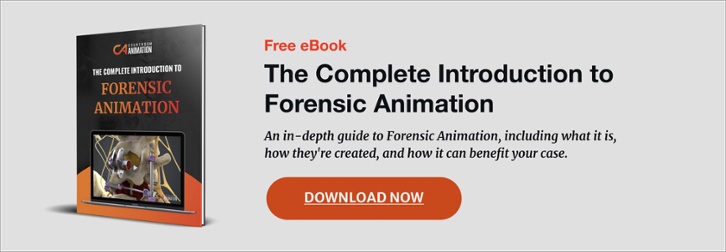
As a plaintiff attorney, you’ve probably relied on Excel graphs, PowerPoint presentations, and short videos to help persuade a mediator, jury, and other decision makers. However, there may be one type of exhibit that your practice is missing: 3D forensic animation.
3D forensic animation is one of the most powerful tools a plaintiff attorney can use to show the opposing counsel, and the jury if necessary, how an event took place. It provides a strategic visualization of your strongest arguments and fact patterns surrounding the people, places, and events that are pertinent to your case.
What is 3D Forensic Animation and How Does it Help Plaintiffs?
Forensic Animation refers to the recreation of civil and criminal cases using modern computer graphics to help decision makers and stakeholders throughout the legal process.
3D forensic animation can be a valuable tool in helping achieve a favorable result for your client in the following ways:
Clarify Your Expert Witness Testimony
Expert witnesses are critical to helping jurors understand nuanced information, such as the details of your plaintiff’s injuries. However, expert witness testimony can be very detailed and complex, and thus sometimes difficult for jurors to remember or follow. The human brain processes information faster when it is presented visually, and this can help highlight to the jury key details and complexities of the testimony.
You need the jury to have a clear understanding of the facts of your case. A 3D forensic animation video can narrate the process, illustrating and reiterating the key details of the expert witness’s testimony. Not only does this make it easier for the jury to follow, but a well-organized animation can also help increase the emotional connection the jury has to your plaintiff’s plight.
By using an animation to clarify and simplify the details from the expert testimony, jurors will remember the nuanced details during deliberations. 3D forensic animation is used to amplify almost any type of expert witness testimony, such as:
- A mechanical engineer describing how a machine malfunctioned
- A medical expert explaining the details of the plaintiff’s injuries
- An accident reconstructionist clarifying how a motor collision occurred
- And many more!
HELPFUL TIP: During your expert’s deposition, show the animations while the opposing counsel is present. This allows the opposing attorney to cross-examine your expert on the foundation. This will go a long way in front of the judge and mitigate any argument of prejudice or surprise.
Settle Your Case Quickly and For More Money
Forensic animation can be used as leverage during mediation, direct settlement talks, and even mock settlement discussions.
Prior to trial, show your animation to as many decision makers and stakeholders as possible. This speaks volumes to your preparation and will likely throw your opposition off kilter.
“I needed a very effective animation of how the incident occurred, with foundation, as well as animations of our client’s injuries and surgeries. This animation was pivotal in causing a zero-offer case to settle for $5.5 million in the afternoon of the first day of trial. I believe the animation caused the defense to develop more concern than we had!”
– Steve Vartazarian, The Vartazarian Law Firm
Armed with a compelling animation, you may cause the defense to reevaluate the strength of their case, and in turn go back to their client and raise their settlement offer. In short, a persuasive visual may catch them off guard and help you reach a quicker settlement and for a higher value.
HELPFUL TIP: Put your animation on the exhibit list early. Putting animations on the exhibit list well in advance of trial puts the opposing counsel on notice that you intend to show it to the jury.
Increase the Chance the Jury Remembers Your Case
Humans are naturally visual learners. If the case goes to trial, a jury listening to in-depth testimony for potentially hours, days, and even weeks might have a hard time concentrating and remembering key details. There’s a chance they could miss vital information. And even if they hear it, they still may not remember it.
According to the book Perceptive Listening, people’s ability to accurately recall what was said to them is about 50% immediately following a presentation, and falls to about 25% after only one day.
Not only do animations make your argument more memorable to the jury, but as discussed earlier, they can be highly impactful in the pre-trial phase. If you’re worried that your forensic animation might not be admitted into court, work with our team of visual strategists and animation experts who maintain a 99% admittance rate in trial.
These reasons and more are why forensic animation can be a valuable asset in any plaintiff attorney’s case.
3D Forensic Animation Strengthens Your Plaintiff’s Case
Using an animated video to support your case can help you to clarify expert witness testimony, settle your case faster, and if you go to trial, ensure the jury remembers key facts. 3D forensic animations are an investment for your case that can pay off for your client.
If you need support for your civil case with forensic animation, it’s important to go to an expert. Courtroom Animation has helped over 2,000 cases with over 500 law firms. Get your 3D forensic animation quote today!

Topics: